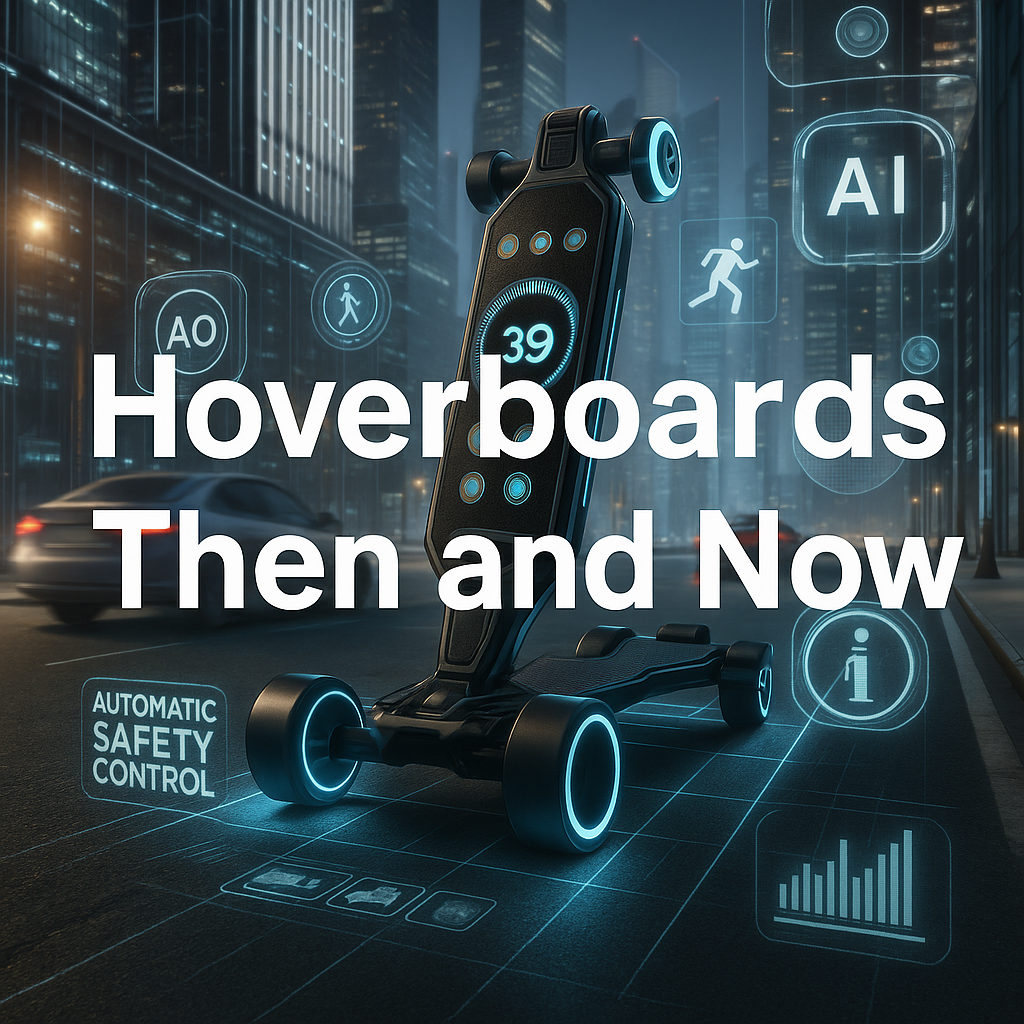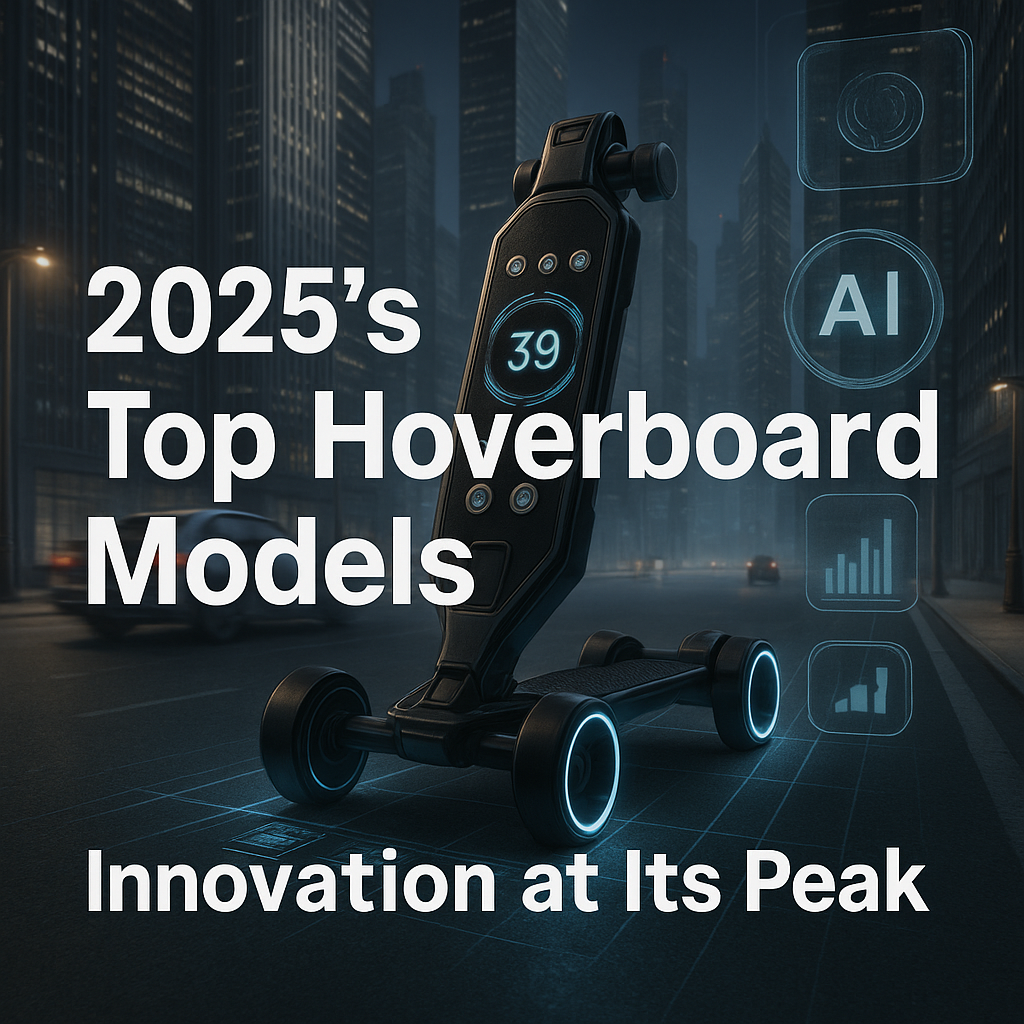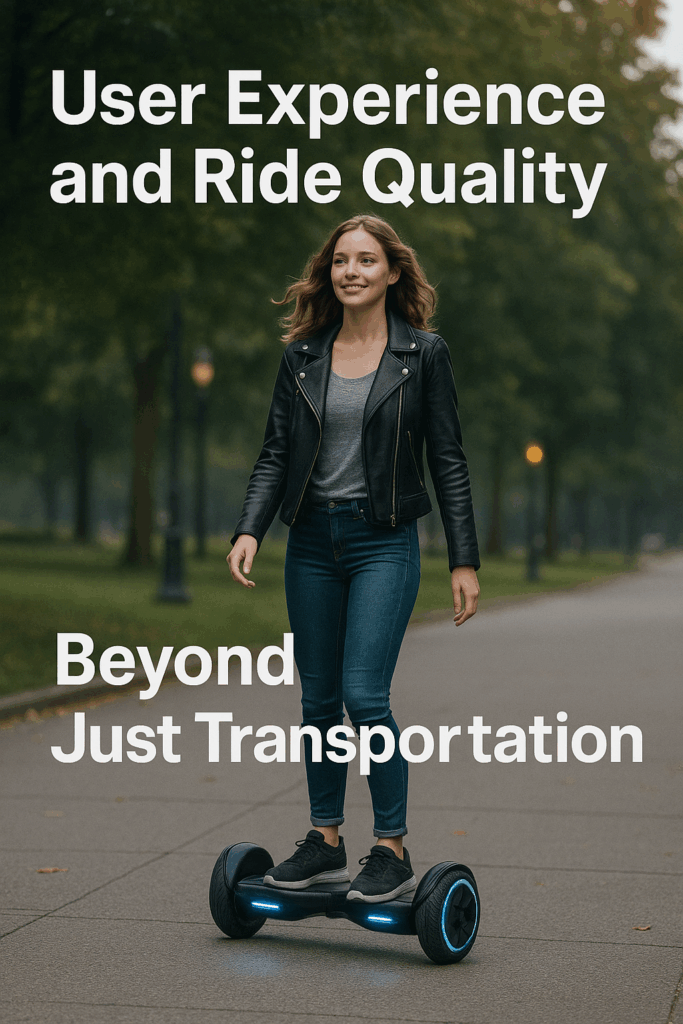
The Hoverboard Trend in 2025: New Models and Promising Features
The Rise of a New Urban Icon
The hoverboard, once a futuristic concept confined to science fiction movies, has now become a staple in modern urban transport. As we step into 2025, hoverboards have evolved far beyond the initial models that graced the market a decade ago. With cutting-edge technology, sleek design, and increased accessibility, hoverboards are redefining personal mobility. This first part of our two-part series will explore the most popular new models released in 2025, analyze their key specifications, and compare their performance, style, and user satisfaction.
Chapter 1: Hoverboards Then and Now – A Journey Through Time and Innovation

Before diving into the latest models, it’s crucial to understand how far hoverboards have come. In their infancy, hoverboards were seen as novelty items—fun, flashy, but somewhat impractical. The early 2010s saw a surge in popularity, driven largely by social media influencers and viral videos. However, these models were often plagued by reliability issues: battery fires, poor balance mechanisms, and fragile builds were common. Despite these setbacks, the potential for hoverboards to revolutionize micro-mobility was clear.
Fast forward to 2025, and the hoverboard has experienced a renaissance. They are now faster, safer, and smarter. Here’s a breakdown of some of the most significant improvements that have transformed the humble hoverboard into a serious mode of transportation:
- Improved Battery Life: Modern hoverboards now boast lithium-ion batteries that last up to 60–70 kilometers on a single charge, with some experimental models exceeding even that.
- All-Terrain Capabilities: Where once they were limited to smooth pavements, today’s hoverboards can handle gravel, sand, snow, and even steep inclines, thanks to enhanced motor torque and robust tires.
- Smart Navigation Systems: Integration with GPS and AI-based pathfinding algorithms means users can now get real-time directions, avoid traffic, and even learn optimal routes based on past usage data.
- Enhanced Safety Features: Auto-stabilization tech, fall detection systems, and pressure-sensitive footpads reduce risks dramatically.
- Connected Ecosystems: Modern hoverboards are now part of a broader IoT network, syncing with phones, watches, and even smart glasses.
The hoverboard is no longer a toy; it’s a legitimate alternative to traditional commuting methods like bicycles and scooters. Urban planners and city developers are even starting to consider hoverboard lanes in their designs.
Chapter 2: 2025’s Top Hoverboard Models – Innovation at Its Peak

Let’s examine the best hoverboards of 2025 based on innovation, design, user reviews, and sales performance. Each of these models has pushed the boundaries of what’s possible with personal transportation.
1. SkyRider X9 Pro
- Battery Life: 70 km per charge
- Max Speed: 28 km/h
- Motor Power: Dual 400W motors
- Special Features:
- Solar-assisted charging panels on the frame
- Biometric fingerprint and retina security lock
- Terrain auto-adapt system with AI analysis
- Adaptive suspension for pothole-heavy routes
- Built-in dashcam and accident recorder
- Design: Matte carbon shell with underglow lighting and customizable decals
- Best For: Long-distance commuters, tech enthusiasts, and digital nomads
- User Review Highlight: “Feels like I’m riding a luxury car on two wheels. The AI knows where I’m headed better than I do.”
2. Glidez AeroFlex
- Battery Life: 55 km
- Max Speed: 25 km/h
- Motor: QuietHub brushless system
- Special Features:
- Foldable design for portability
- Real-time traffic alerts via integrated app
- AI-assisted balance correction based on terrain shifts
- Carbon-reinforced body, lightweight yet durable
- Anti-theft smart lock with GPS tagging
- Best For: Urban professionals, students, and travelers
- User Review Highlight: “I take it everywhere – train, office, even cafes. Fold it, park it, forget it.”
3. VoltCruze 360
- Battery Life: 60 km
- Max Speed: 30 km/h
- Motor Configuration: Tri-core propulsion with advanced cooling
- Special Features:
- Holographic display panel with voice command
- Bluetooth-enabled smart helmet sync
- Collision anticipation and auto-stop system
- Emergency beacon light for night rides
- Best For: Advanced users, tech lovers, urban explorers
- User Review Highlight: “It’s not a board, it’s a spaceship on wheels. Love the hologram interface!”
4. NeoHover TrailMaster
- Battery Life: 50 km
- Max Speed: 22 km/h
- Motor: Heavy-torque off-road drive
- Special Features:
- Thick tread wheels with shock absorption
- Waterproof IP68 rating
- LED headlamps with night vision mode
- Emergency SOS signal in case of crash
- Trail-mapping and breadcrumb tracking
- Best For: Nature lovers, adventurers, off-road riders
- User Review Highlight: “Took it hiking last week. Mud, stones, slopes – it tackled everything. 10/10 for thrill.”
Chapter 3: User Experience and Ride Quality – Beyond Just Transportation

In 2025, user experience is paramount. The hoverboard market has matured, and consumers are no longer content with basic functionality. They expect refinement, reliability, and a sense of joy when riding. To meet this demand, manufacturers are focusing more than ever on delivering an immersive, intuitive riding experience.
One of the major shifts has been the development of adaptive ride algorithms. These algorithms continuously learn from the rider’s habits and terrain patterns. If a rider prefers smooth, cautious starts, the hoverboard adapts. If a rider enjoys fast acceleration, the hoverboard learns to deliver more torque accordingly.
Real-time Performance Monitoring has also become standard. Through mobile apps, users can track metrics like:
- Battery health and charge cycles
- Speed trends and mileage
- Terrain difficulty ratings
- Environmental conditions such as wind resistance
Furthermore, Ergonomic Footpad Design has evolved to reduce strain on knees, ankles, and hips. Manufacturers use memory foam-based footpads that mold to the user’s feet over time, minimizing fatigue during long rides.
Ride Mode Customization is another user-centric feature. Riders can select from:
- Beginner Mode: Enhanced balance and capped speed
- Eco Mode: Energy-efficient for long-range cruising
- Sport Mode: Full power and quick response for experienced users
- Expert Mode: Manual override settings for fine-tuned control
Finally, riders in 2025 expect fun as part of the ride. Boards now feature integrated music playback, customizable LED patterns, voice feedback, and even emotion-based responses based on biometric readings. One popular feature is the board responding to mood changes—glowing blue during a relaxed cruise or pulsing red during intense speeds.
Chapter 4: Design and Aesthetic Trends – The New Look of Mobility
Hoverboards in 2025 aren’t just about performance—they’re fashion statements. Brands have taken design philosophy to new heights, turning hoverboards into symbols of status, style, and eco-conscious innovation.
Minimalist Geometry remains the dominant design trend. Smooth curves, hidden wheels, matte finishes, and seamless transitions between surfaces give boards a futuristic and sleek appearance. Some brands are collaborating with luxury designers to create limited-edition aesthetics using high-end materials like titanium, carbon fiber, and even vegan leather.
LED Customization has become an obsession among younger users. Modern hoverboards come with fully programmable RGB lighting systems that:
- Sync with music beats via mobile apps
- Display navigation indicators or traffic signals
- Reflect ride modes through color patterns
- Provide ambient light during night rides
Color Palettes are becoming more expressive, with some brands offering seasonal or artist-designed skins. Users can swap panels or apply high-tech vinyl wraps to personalize their boards.
Eco-conscious Design is also a significant trend. Brands are incorporating:
- Recycled aluminum chassis
- Bio-synthetic rubber wheels
- Paint-free coating techniques
- Packaging made from mushroom-based biodegradable materials
Even accessories are following suit. Backpacks, helmets, and hoverboard cases are now designed with sustainable fabrics and minimalist aesthetics.
Design is now a deciding factor in consumer choice. As one user put it in a review: “I didn’t just buy a hoverboard—I bought a lifestyle.”
Chapter 5: Smart Features That Set the Standard – Intelligence on Wheels
The smartest hoverboards in 2025 are more than transportation devices—they are intelligent personal assistants on wheels. Integrating artificial intelligence (AI), cloud computing, and sensor fusion, these hoverboards are now capable of responding to a rider’s environment in real-time while offering intuitive interaction.
One of the most popular features is AI Route Learning. Hoverboards now map out frequently used paths, memorize environmental changes, and suggest faster or safer alternatives. The AI improves over time, learning to avoid high-traffic areas, uneven roads, or construction zones. For commuters, this reduces travel time and increases ride safety.
Voice Assistant Integration is another leap forward. Hoverboards now pair with digital assistants like Alexa, Siri, and Google Assistant. Riders can give voice commands such as:
- “What’s my battery level?”
- “Take me to the nearest coffee shop.”
- “Start navigation to work.”
More advanced models even support gesture control using embedded motion sensors. Riders can tilt their heads or swipe a hand in the air to signal turns, adjust speed, or toggle lights.
Security has also evolved. Remote Locking and Theft Tracking are now standard. Users can lock and unlock their boards using biometric authentication (fingerprint or face scan) on their smartphones. If a hoverboard is moved without authorization, it emits a loud alarm and sends its real-time location to the owner.
Other cutting-edge features include:
- Auto-Self Diagnostics: Predicts mechanical or software issues before they occur
- Over-the-Air (OTA) Updates: Firmware upgrades and new features downloaded wirelessly
- Cloud Ride History: Access logs of all rides, routes, and user habits for analysis
- Environmental Scanners: Detects nearby vehicles, obstacles, and pedestrians
- Multilingual Voice Feedback: Supports various languages and local dialects
These smart systems not only elevate the hoverboarding experience but also pave the way for future automation and potential self-driving capabilities.
Chapter 6: Challenges and Considerations – The Road Ahead Isn’t Always Smooth
Despite the immense progress, hoverboards in 2025 still face challenges—some technological, others social and regulatory.
The first major hurdle is Legal Uncertainty. Hoverboard regulations differ wildly from city to city and country to country. In some regions, they are fully integrated into public transport policies, while in others, they are banned from sidewalks or roads. Riders often struggle with inconsistent laws regarding where and how they can use their devices.
To combat this, hoverboard companies are lobbying for standardized regulations and working with urban planners to create dedicated lanes, much like those for bicycles and electric scooters. Some cities, such as Amsterdam and Seoul, are already leading the way with pilot programs and hoverboard-friendly infrastructure.
Battery Technology also presents an ongoing concern. While lithium-ion batteries have improved, they are still prone to degradation, environmental harm, and safety issues in rare cases. Some companies are exploring solid-state batteries or graphene-based energy cells, which promise longer life, faster charging, and enhanced thermal stability.
Another consideration is the Learning Curve for New Users. Though hoverboards are more intuitive than ever, first-time riders still need to overcome initial fears and balance challenges. This has led to a rise in:
- Hoverboard Training Schools
- Virtual Simulation Apps
- Beginner Support Communities
Manufacturers are also addressing this by including step-by-step video tutorials, interactive onboarding through AR (Augmented Reality), and beginner-safe modes with guided movement.
Lastly, Affordability and Access remain concerns. Top-tier models can cost anywhere from $1,000 to $3,500. While luxury versions offer unbeatable features, budget-conscious consumers often feel left out of the trend. In response, some brands have launched modular hoverboards where users can start basic and upgrade hardware over time.
As with any evolving technology, these growing pains are to be expected. What matters most is the collective effort by manufacturers, cities, and communities to shape hoverboarding into a safe, inclusive, and sustainable mobility solution.
Chapter 7: Market Growth and Demographics
The global hoverboard market is expected to reach $4.3 billion by the end of 2025. Demographics show a shift:
- 18-35 remains the core buyer group
- 36-50 usage is growing fast
- Seniors using hoverboards for leisure and assisted mobility
The versatility of hoverboards is expanding their user base across age groups and lifestyles.
Tags: electric hoverboards, hoverboard 2025, personal transport, smart mobility, urban commuting



